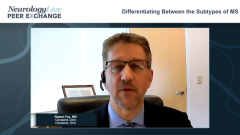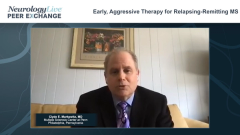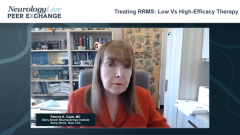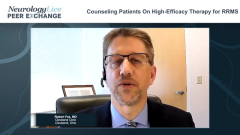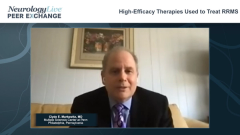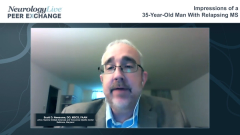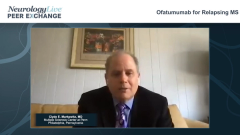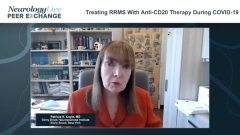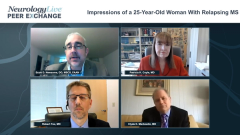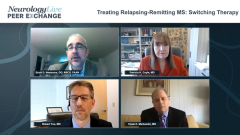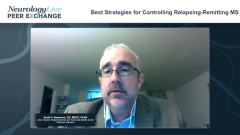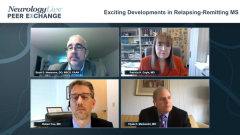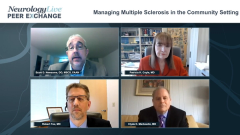
High-Efficacy Therapies Used to Treat RRMS
An overview of high-efficacy therapies available to treat patients with relapsing-remitting multiple sclerosis.
Episodes in this series

Scott D. Newsome, DO, MSCS, FAAN: Clyde, there may be some nuances to this, but what falls under the umbrella of high-efficacy therapies? What do you consider high efficacy?
Clyde E. Markowitz, MD: I’ll comment on a couple of things that have been said so far. One thing I struggle with is—actually 2 things. It’s probably a lot more, but there are at least 2 that I struggle with right now.
Scott D. Newsome, DO, MSCS, FAAN: I was going to say, I think it’s a lot more than 2.
Clyde E. Markowitz, MD: It is. You’re right. The reality is that most patients come to us for our expertise. They do not know all that we know with regard to therapies, adverse effects, safety concerns, etc. I am a big fan of the shared decision-making idea, but I also have to guide my patients into what I believe is the best approach. The piece that lives with me is something I do not exactly know how to describe, but it is like something is missing. What I am missing is this: I look at the TV, and they have these advertisements on TV all the time for all these rheumatology drugs, or for Crohn disease, or whatever, and they list all the adverse effects. Our patients have a central nervous system disease that affects who they are and how they are going to be functioning on the planet. We are worried about a small-risk profile, compared with the rheumatologists who are worried about patients having a little more joint pain or swelling in their joints. The patients are all going on these scary drugs, just like our scary drugs, but we seem to be more concerned than the rheumatologists are about this stuff. I struggle with that because as neurologists we need to become way more comfortable with risk, and these risks are fairly small in reality. There are definitely issues, and we know how to manage them.
In terms of which drugs I would put in this category, back in the day we had our first intravenous medication with mitoxantrone. Mitoxantrone is a chemotherapy drug, and we were all like, “This is going to be great.” Then we saw the adverse effects, and it did not look like a great option after we saw leukemia, heart failures, etc. Natalizumab became available, and natalizumab, in my opinion, was the best drug available at the time, but we had this concern for PML [progressive multifocal leukoencephalopathy]. We have figured out, for the most part, how to mitigate risk in that conversation, with JC [John Cunningham] virus antibody status and by making sure they are on no other immunosuppressive drugs. We know how to manage risk within that, so I put natalizumab as a high-efficacy compound.
As time has gone on, we were able to look at some of the oral agents. When fingolimod became available, that also became a higher-efficacy drug because it was compared with some of the injectable drugs, and it was clearly shown to be better. I put the S1Ps as a group because they’re a higher-efficacy compound. More recently, we’ve had approvals for oral cladribine as well as alemtuzumab. Most recently, the anti-CD20 agents. I put all those in a high-efficacy conversation. When you look at risk, most feel fairly comfortable with the anti-CD20 agents that we have been using, with ocrelizumab for the last 4 years almost. We have ofatumumab that has come out recently.
We have a fairly good handle on monitoring patients and what the safety concerns look like, but as time went on, we got thrown into a pandemic. We have to worry about vaccinating our patients in a conversation about whether these drugs are safe. How do patients do with regard to not having adequate amounts of peripheral B cells if that is a concern? So far, a year into a pandemic, it looks to us that our patients on these drugs are doing fairly well. There could be some issues there with the anti-CD20 agents with regard to a slightly higher risk for hospitalization or possibly intubation. At least it does not appear that our patients with MS [multiple sclerosis] are having a higher rate of mortalities in this regard.
We now have to struggle with this whole world of vaccinations and whether our patients are going to be adequately vaccinated for COVID-19, which is a major problem. We have the possibility for these drugs to be effective in controlling disease activity, but we have to have some conversation about whether it’s safe, A) during a pandemic and B) with some of the comorbidity issues we concern ourselves with. This is why we have these lengthy conversations with our patients in the shared decision-making process about what the risks are and what the benefits are. At the end of the day, I’m going to tell you that the high-efficacy compounds are controlling disease activity better than we ever had with any of the earliest medications we tried for treating MS.
Scott D. Newsome, DO, MSCS, FAAN: Interesting. I want to give the ball to Pat and Bob because I agree with most of what you said, Clyde, in terms of which therapeutics fall under this category, with the exception of 1. What about you, Pat and Bob? Where are your heads in terms of the high-efficacy drugs?
Patricia K. Coyle, MD: I talk about moderate and high efficacy. The high-efficacy drugs are the monoclonal antibodies. A bit below that, I would put oral cladribine, which is obviously an induction-durable immuno-constitution agent. We think of that as a subset of high-efficacy issues, so cladribine is a little low. I do not rank the S1P receptor modulators as high efficacy, but within the oral cohort, they would probably be a bit near the top of the list in efficacy based on some objective data we have had.
Robert Fox, MD: I would agree with part of that. I think of the S1P modulators in the moderate efficacy category. I have heard several people mention that S1P modulators are a bit more effective than the fumarates, but the real-world evidence does not support that. When people have gone out and done propensity matching in the real-world cohorts, they found that DMF [dimethyl fumarate] and fingolimod have similar efficacies, so I put those oral agents into a moderate-efficacy category. Then for natalizumab, ocrelizumab, and the not-labeled-for-MS rituximab, I put them in the highly effective category.
Scott D. Newsome, DO, MSCS, FAAN: Thank you for watching this Neurology Live® Peer Exchange. If you enjoyed the content, and I hope you did, please subscribe to our e-newsletters to receive upcoming Peer Exchanges and other great content right in your in-box.
Transcript Edited for Clarity
Newsletter
Keep your finger on the pulse of neurology—subscribe to NeurologyLive for expert interviews, new data, and breakthrough treatment updates.


